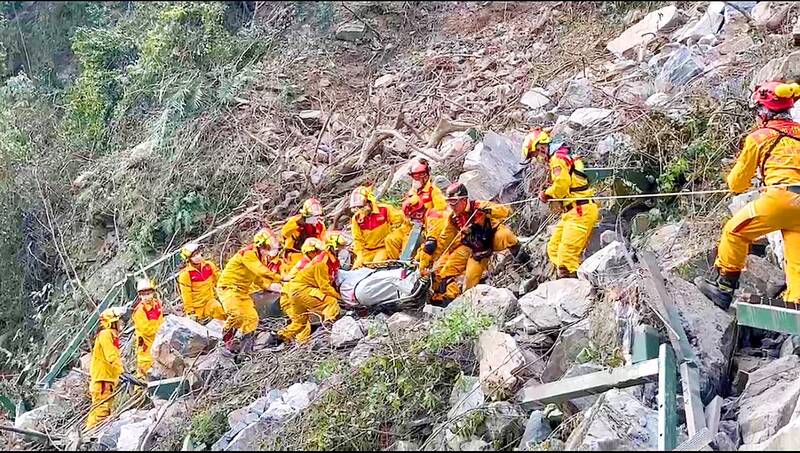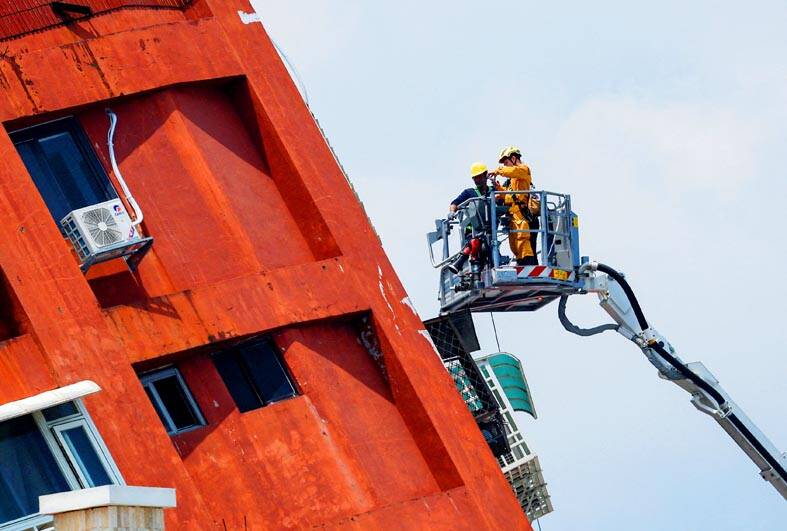The death toll from Wednesday’s magnitude 7.2 earthquake rose to 10, while 1,099 people were injured and 15 were missing, in addition to 705 people who remained trapped, the National Emergency Response Center said at 8:40pm yesterday.
The latest fatality, previously listed as missing, was a man hiking on Xiaozhuilu Trail (小錐麓步道) in Hualien County. He was found under rocks and his remains were transported out of the area in the late afternoon.
The 17 other hikers who had registered their details with the Taroko National Park were all accounted for, the park management office said.

Photo courtesy of the Pingtung County Bureau of Fire and Emergency Services
All of the known fatalities occurred in Hualien County, with falling rocks accounting for every death except one person who died in the partially collapsed Tien Wang Hsing Building (天王星大樓) in Hualien City.
First responders rescued 44 people trapped in the No. 1 and No. 2 lighted tunnels on the Central Cross-Island Highway, which includes Provincial Highway No. 8, the center said.
This 44 comprised 35 employees of Silks Place Taroko in the No. 1 tunnel, three of whom sustained non-critical injuries, and nine tourists in the No. 2 tunnel, all of whom were unscathed.

Photo: Carlos Garcia Rawlins, Reuters
Rescuers established contact with a group of 21 tourists and five employees of the hotel sheltering near the Tunnel of Nine Turns on the highway.
Three hotel employees and three foreign tourists escaped the area on foot.
Seventy-one foreigners were rescued from mountain areas in Hualien, while one Indian, one Canadian and two Australians remained unaccounted for, the Ministry of Foreign Affairs told a routine news conference yesterday.

Photo: An Rong Xu, Bloomberg
Those rescued include six people from the UK, three from France, two from Australia, seven from the US, four from Israel, three from Canada, 25 from Germany, seven from Switzerland, eight from Singapore, two from Hungary and four from the Netherlands, it said.
Separately, the National Park Service issued a notice urging the public to avoid mountain areas for the time being, as multiple areas have become unstable from the quake.
Taipingshan (太平山), Chihnan (池南), Fuyuan (富源), Lintianshan (林田山), Danong Dafu (大農大富) and Rueisuei (瑞穗) forest parks, as well as Syakaro Historic Trail, and all parks and trails in Hualien and Yilan counties are closed, it said.

Photo: Sam Yeh, AFP
People already in the areas are advised to depart via a safe route, the National Park Service added.
Central Weather Administration data showed that as of about 2pm yesterday, 365 aftershocks had hit Taiwan. As of 1:57pm, 207 of the aftershocks were magnitudes 3 to 4, 140 were magnitudes 4 to 5 and 16 were magnitudes 5 to 6.
There were two aftershocks of magnitudes 6.5 and 6.2 that struck at 8:11am and 10:14am on Wednesday respectively.
Several buildings in Nanjichang Neighborhood (南機場) in Taipei’s Wanhua District (萬華) had damage ranging from cracked walls to deformed pillars, the Taipei City Government said yesterday.
Following an assessment by outside experts, city officials ordered residents to evacuate one of the affected buildings, with the operation completed on Wednesday evening, it said, adding that measures were being implemented to temporarily support the structure.
Taipei Association of Architects deputy head Lin Chih-sung (林志崧) said that the antiquated single-span design of the building is structurally weak and that it might have to be demolished if the damage is severe.
The neighborhood was part of a housing project completed in 1964.
Also yesterday, the Ministry of Foreign Affairs said that China was “shameless” after Chinese Deputy Permanent Representative to the UN Geng Shuang (耿爽) thanked the world for its concern about a strong earthquake.
At a meeting about children’s rights, Geng said that another speaker had brought up the quake in “China’s Taiwan.”
China is concerned about the damage and has expressed condolences to Taiwan and offered aid, he said, according to a transcript of his remarks carried on the Chinese mission to the UN Web site.
“We thank the international community for its expressions of sympathy and concern,” he added.
The ministry “solemnly condemns China’s shameless use of the Taiwan earthquake to conduct cognitive operations internationally,” it said, adding that this shows China has no goodwill toward Taiwan.
Additional reporting by Reuters

LIMITS: While China increases military pressure on Taiwan and expands its use of cognitive warfare, it is unwilling to target tech supply chains, the report said US and Taiwan military officials have warned that the Chinese People’s Liberation Army (PLA) could implement a blockade within “a matter of hours” and need only “minimal conversion time” prior to an attack on Taiwan, a report released on Tuesday by the US Senate’s China Economic and Security Review Commission said. “While there is no indication that China is planning an imminent attack, the United States and its allies and partners can no longer assume that a Taiwan contingency is a distant possibility for which they would have ample time to prepare,” it said. The commission made the comments in its annual

DETERMINATION: Beijing’s actions toward Tokyo have drawn international attention, but would likely bolster regional coordination and defense networks, the report said Japanese Prime Minister Sanae Takaichi’s administration is likely to prioritize security reforms and deterrence in the face of recent “hybrid” threats from China, the National Security Bureau (NSB) said. The bureau made the assessment in a written report to the Legislative Yuan ahead of an oral report and questions-and-answers session at the legislature’s Foreign Affairs and National Defense Committee tomorrow. The key points of Japan’s security reforms would be to reinforce security cooperation with the US, including enhancing defense deployment in the first island chain, pushing forward the integrated command and operations of the Japan Self-Defense Forces and US Forces Japan, as

‘TROUBLEMAKER’: Most countries believe that it is China — rather than Taiwan — that is undermining regional peace and stability with its coercive tactics, the president said China should restrain itself and refrain from being a troublemaker that sabotages peace and stability in the Indo-Pacific region, President William Lai (賴清德) said yesterday. Lai made the remarks after China Coast Guard vessels sailed into disputed waters off the Senkaku Islands — known as the Diaoyutai Islands (釣魚台) in Taiwan — following a remark Japanese Prime Minister Sanae Takaichi made regarding Taiwan. Takaichi during a parliamentary session on Nov. 7 said that a “Taiwan contingency” involving a Chinese naval blockade could qualify as a “survival-threatening situation” for Japan, and trigger Tokyo’s deployment of its military for defense. Asked about the escalating tensions

The Ministry of Economic Affairs said it plans to revise the export control list for strategic high-tech products by adding 18 items under three categories — advanced 3D printing equipment, advanced semiconductor equipment and quantum computers — which would require local manufacturers to obtain licenses for their export. The ministry’s announcement yesterday came as the International Trade Administration issued a 60-day preview period for planned revisions to the Export Control List for Dual Use Items and Technology (軍商兩用貨品及技術出口管制清單) and the Common Military List (一般軍用貨品清單), which fall under regulations governing export destinations for strategic high-tech commodities and specific strategic high-tech commodities. The